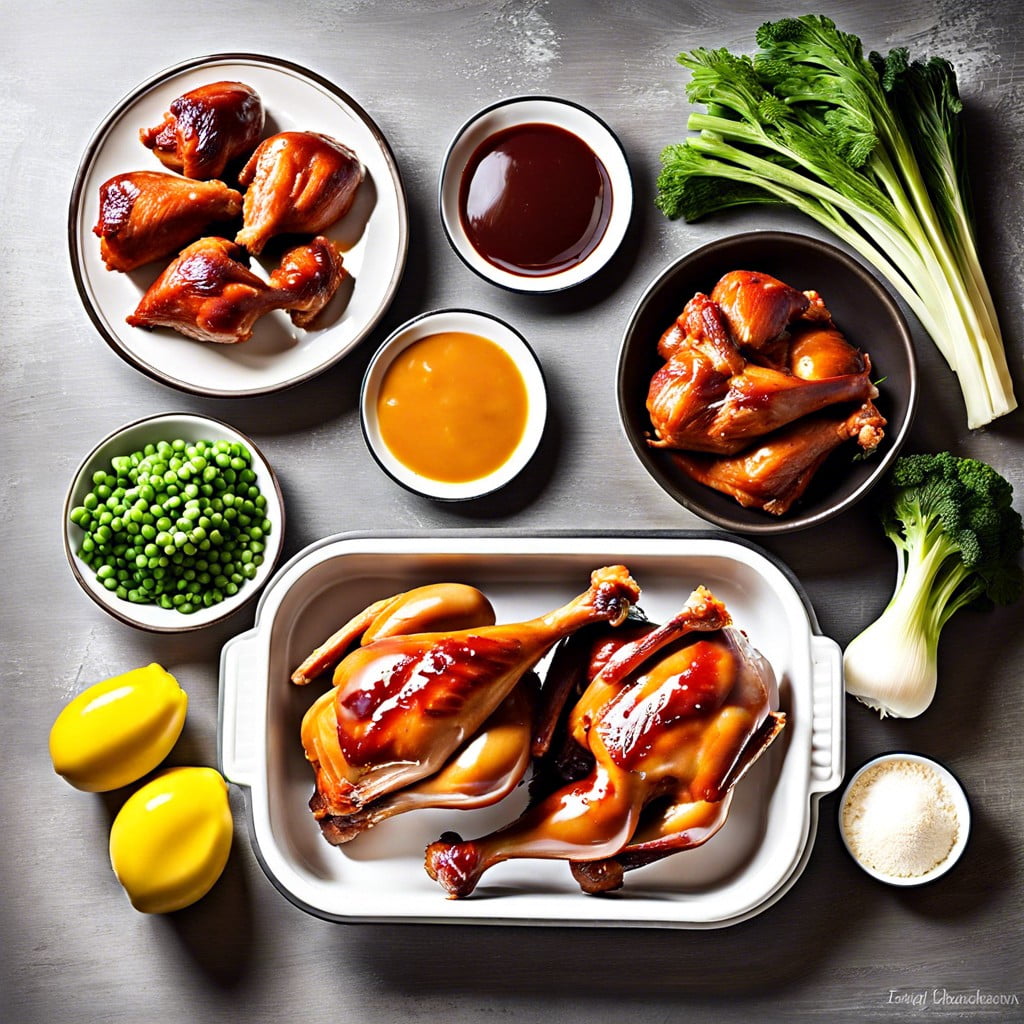Learn how to master the art of baking BBQ chicken in your oven for a flavorful and moist result every time.
Key takeaways:
- Use bone-in, skin-on pieces for maximum flavor & moisture retention.
- Apply marinade with olive oil, spices, and acid for tender chicken.
- Balance the BBQ sauce with sweet, tangy, and smoky flavors.
- Bake at 375°F, glaze with BBQ sauce every 10 minutes.
- Test for doneness with a meat thermometer or visual cues.
Ingredients for Oven Baked BBQ Chicken

The success of oven-baked BBQ chicken hinges on a balance of simple, quality ingredients. Opt for bone-in, skin-on pieces such as thighs and drumsticks for optimum flavor and moisture retention. Their robust texture stands up to the heat while absorbing the rich BBQ sauce.
For the marinade, a mix of olive oil, garlic powder, paprika, salt, and pepper creates a perfect base layer to complement your BBQ sauce. A little acid, such as apple cider vinegar or lemon juice, in the marinade tenderizes the chicken and adds zest.
As for the BBQ sauce, a balanced profile of sweet, tangy, and smoky flavors is key. Whether homemade or store-bought, ingredients like tomato paste, molasses, brown sugar, vinegar, and various spices can be adjusted to personal taste.
Finally, a light brushing of sauce during the final minutes of baking will not only enhance flavor but will also help achieve that desirable sticky, caramelized exterior characteristic of a top-notch BBQ chicken.
How to Make Baked BBQ Chicken in the Oven
Begin by preheating your oven to 375 degrees Fahrenheit to ensure it reaches the appropriate cooking temperature. While the oven is heating, pat the chicken pieces dry with a paper towel; moisture can prevent the skin from achieving that desired crispiness.
Coat the chicken evenly with olive oil, salt, pepper, and any additional spices to build a flavor base. Place the chicken on a wire rack within a baking tray; this setup promotes air circulation, achieving uniform cook-and-crisp. Bake for about 20 minutes before applying any BBQ sauce; this step allows the meat to cook without burning the sauce.
When it’s time to glaze, brush your chosen BBQ sauce generously onto the chicken pieces, coating every nook and cranny. Continue to bake, re-glazing every 10 minutes, until the internal temperature reaches 165 degrees Fahrenheit, measured at the thickest part of the meat without touching bone. This repeated glazing technique creates layers of caramelized BBQ flavor.
Rotate the tray halfway through the cooking process to ensure even browning and consistent heat distribution. Resist the urge to over-coat with sauce too early; patience rewards you with perfectly baked BBQ chicken.
BBQ Sauce Selection: Homemade Vs. Store-Bought
Choosing between homemade and store-bought BBQ sauce can elevate your baked chicken. Homemade sauce affords control over sweetness, tartness, and spice levels, allowing you to tailor flavors to your preference. Consider using fresh ingredients like ripe tomatoes, vinegar, brown sugar, and a personalized blend of spices for a unique touch.
On the flip side, store-bought sauces offer convenience and consistency. For those pressed for time or seeking a familiar taste, it’s a reliable option. High-quality brands often feature a range of flavors, from smoky and rich to tangy and sweet, which can complement the chicken without overwhelming it.
Both options have their merits; the choice ultimately depends on time availability and taste desires. Whether you opt for a sauce from scratch or a trusted bottled variety, ensure it complements the chicken rather than overpowering it. Balance is key in achieving a harmonious dish.
Correct Oven Temperatures and Cooking Times
Achieving perfectly baked BBQ chicken hinges on temperature precision and timing. Set your oven to 375°F (190°C), a sweet spot that cooks the chicken thoroughly without drying it out or leaving it undercooked.
Expect bone-in pieces to require about 45 minutes, while boneless cuts often need no more than 20-25 minutes.
For layered flavors, add sauce during the last 10 minutes of cooking to prevent burning and to allow the sauce to caramelize nicely.
Always use a meat thermometer to ensure the chicken has reached a safe internal temperature of 165°F (74°C) at the thickest part, avoiding bone contact for an accurate reading.
Testing for Doneness: Ensuring Chicken Is Fully Cooked
To guarantee your chicken has reached a safe internal temperature without compromising its succulent juiciness, use a meat thermometer. Insert the probe into the thickest part of the meat, avoiding bone, which conducts heat and could give a false high reading. What you’re aiming for is 165°F (75°C) – the magic number the USDA deems safe for poultry.
For those without a meat thermometer, there’s the visual and tactile test. Juices should run clear when the meat is pierced near the bone; if you notice any pink-tinged liquid, it needs more time. The meat should also pull away from the bone with ease, and when pressed, the chicken shouldn’t feel rubbery or give too much resistance.
Remember, carryover cooking will increase the temperature slightly even after you remove the chicken from the oven, so it’s prudent to consider this in your timing. With the right techniques, dry, overcooked chicken will be a tale of the past.

